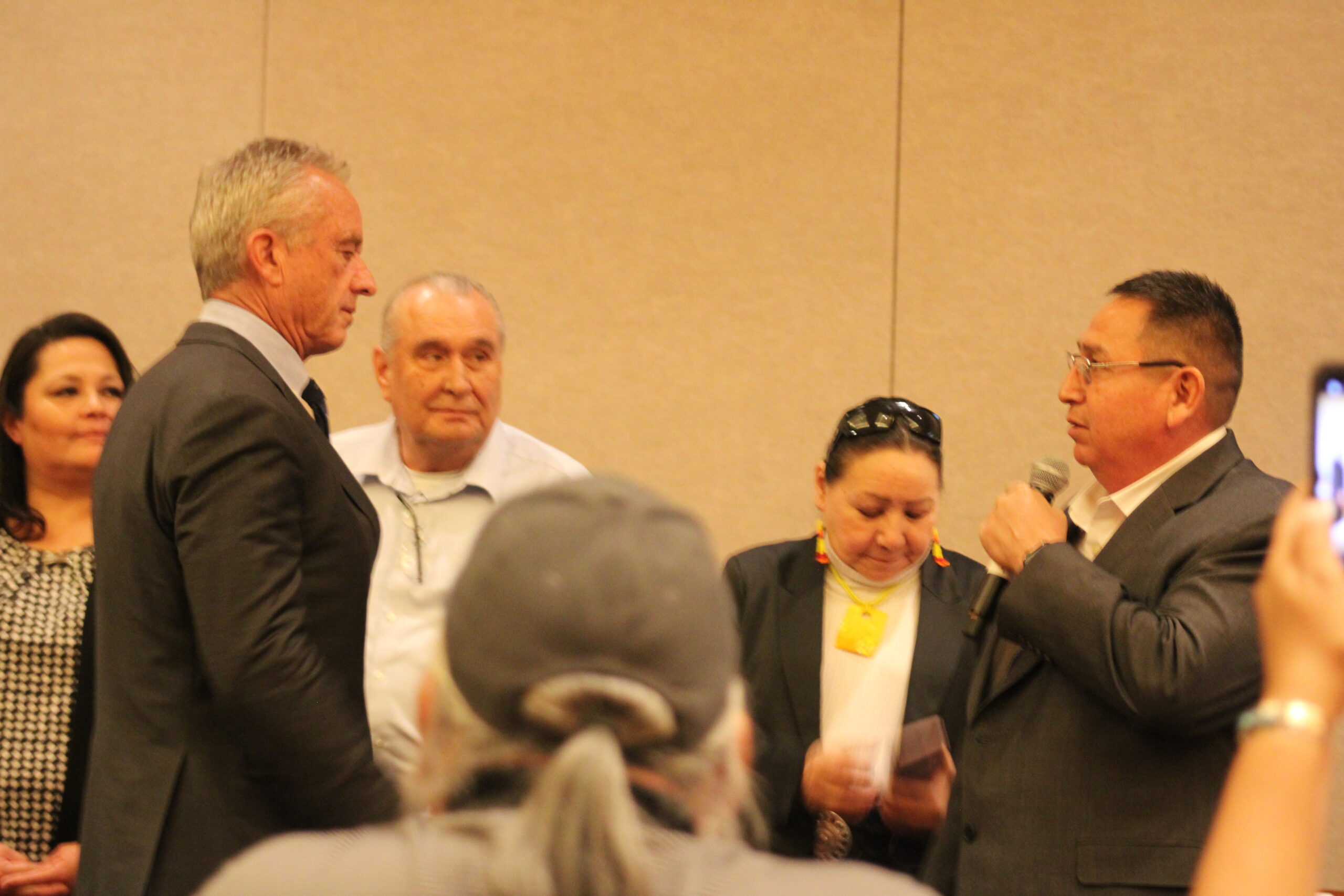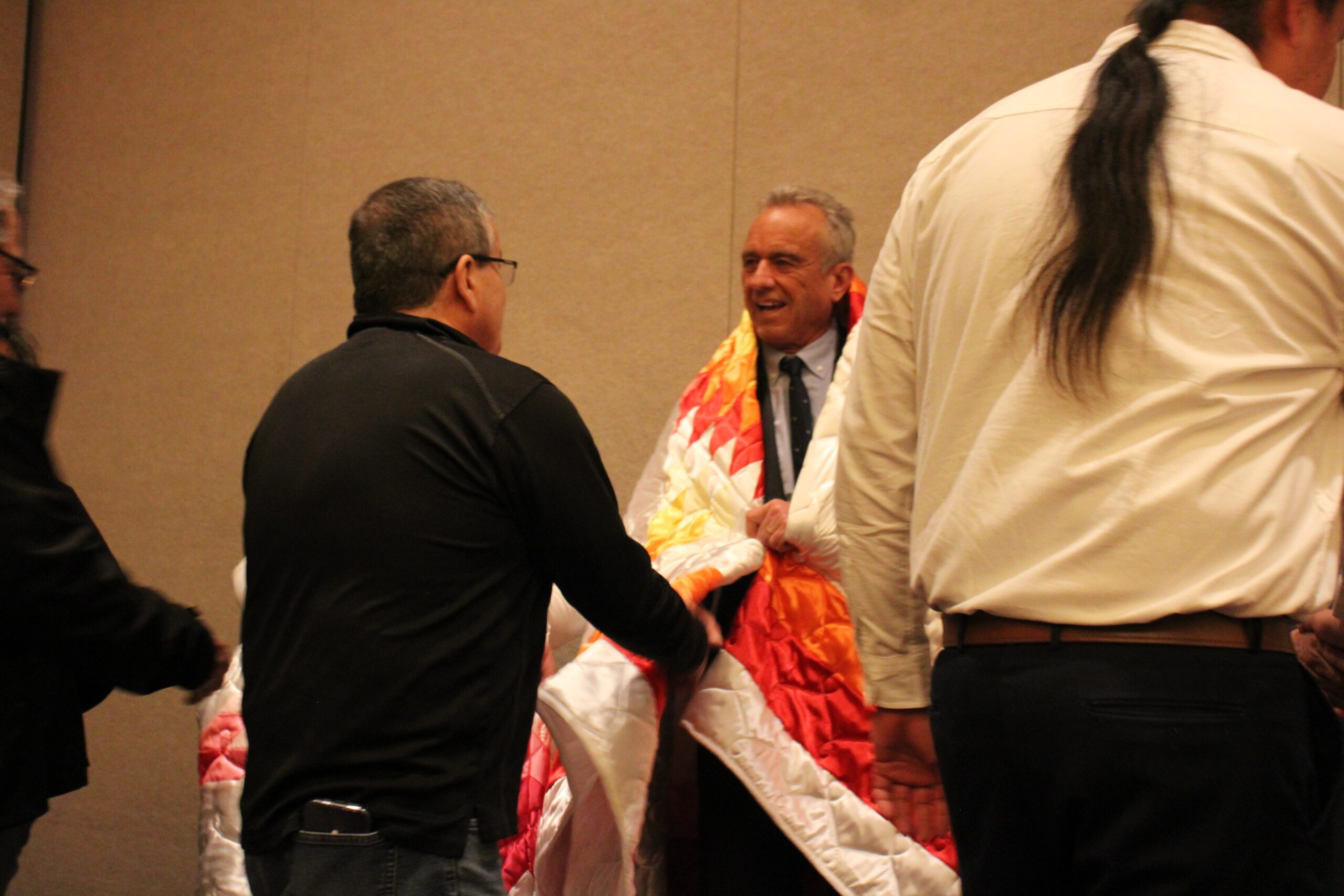Robert Kennedy Jr. visits tribes at COLT quarterly meeting to share his presidential platform to Indian Country

Oglala Sioux Tribal President Frank Star Comes Out gives thanks to Robert Kennedy Jr. for his family’s commitment to the Lakota people and presented a star quilt from the Oglala community. Photo by Darren Thompson
LAS VEGAS – Presidential candidate Robert Kennedy Jr. recently made an official campaign stop with the Coalition of Large Tribes (COLT) to pledge his commitment to Tribal Nations as part of his platform. Kennedy’s visit was just prior to the National Center for American Indian Enterprise Development’s (NCAIED) Reservation Economic Summit on Friday, March 8 at Ceasar’s Palace, where he presented to nearly 60 tribal leaders representing COLT’s membership tribes and others.
As Kennedy began his presentation he said, “I wanted to talk about my history of commitment to Tribal issues and Indians across the country.” He then shared his family’s visits to the Lower Brule, Rosebud Sioux, and Pine Ridge Indian Reservations in the 1960’s, where Kennedy then highlighted that Lakota voter turnout in the reservation communities voted 99% for his father’s —Robert F. Kennedy—primary election on June 4, 1968. Kennedy visited Chadron and the Pine Ridge Indian Reservation with Lakota Times founder Tim Giago on April 16, 1968, where many reports shared that Kennedy was appalled by conditions on South Dakota’s reservations.
Kennedy would win South Dakota’s primary on June 4, 1968, over Vice President Humphrey and Senator Eugene J. McCarthy, and would be assassinated in Los Angeles on June 5, 1968.
“On the day my father was killed, he won 99% of the vote on the Pine Ridge Indian Reservation,” Kennedy said.
Robert Kennedy Jr.’s, father was appointed as the 64th U.S. Attorney General while his uncle, John F. Kennedy Jr., served as the 35th President of the United States. While he served as Attorney General, Kennedy said that he remembered his father hired many Native people in his administration and they were often visitors at their house while in Washington, D.C.
“My uncle’s Administration always had open doors to Tribal leaders, and many of them brought our family gifts included headdresses, pipes, beaded moccasins, blankets, and they are still in our family.”
Kennedy also took the opportunity to share some of his family’s insight and their commitment to Indian people. He said that his father and his uncles talked about their family’s beginnings, where both sets of his grandparents left Ireland in 1848, during the height of the Irish Potato Famine. “My father and my uncle, John F. Kennedy Jr., would talk a lot about the Choctaws during the Great Irish Famine in 1848 when over a million Irish starved to death and my grandparents on both sides of my family were a part of the flood of Irish that left that year and came to Boston.”
The Choctaws raised $170 during the famine and then sent to people in Ireland who were starving to death. “My father thought that was something we shouldn’t forget,” Kennedy said of his father.
When his father visited Pine Ridge in 1968, he saw a Lakota family living out of a burned out car and it made him cry Kennedy said. “When he visited the Pine Ridge Indian Reservation in 1968, he saw a family of Sioux living out of a burned out car and that made him cry. That’s something I’ve never saw in my lifetime, even when my uncle passed away and that was crushing to him,” he said.
After sharing his upbringings, he continued to share his commitment into his adult years, including being one of the founding editors of The Lakota Times with founder Tim Giago in 1968. The Lakota Times then became Indian Country Today, which today is one of the oldest and largest news publications in Indian Country.
Since, he has spent most of adult life as an environmental attorney where he said 20% of his career’s work has been advocating for Tribes in both the U.S. and Canada. He would found the largest water protector organization in the world, the WaterKeeper Alliance, and would serve as its president for 21 years. Today, the organization, which protects 2.7 million miles of water ways, is the largest nonprofit dedicated to protecting water in the world.
He also brought up his arrest in 2013 in Washington, D.C., for protesting the Keystone Pipeline project with his son Conor—where attendees all applauded. He also shared he brought his children to the Dakota Access Pipeline protests near the Standing Rock Indian Reservation in 2016.
Presidential Platform Friday’s meeting was Kennedy’s first official visit to speak with tribal leaders while running for the presidency. Kennedy announced his candidacy as an independent for the President of the United States on October 9, 2023 and has since campaigned throughout the country. His poll numbers are high, and many are labeling his campaign as a spoiler campaign, where he may “steal” votes from other parties.
While Kennedy didn’t openly make promises as to what he would do for Tribes, he did pledge to free Leonard Peltier, tripling White House spending to Tribal communities, investing in regenerative agriculture, and having an open door for Tribal leaders at the White House.
“Leonard Peltier is 79 years old and frail, he’s not a danger to society,” Kennedy said of his support for the release of Leonard Peltier. “The importance he plays in a world of Indian people, the symbolic role he plays, and it’s important we free him and bring everyone together in this country.”
“We need to make our spaces sacred again, make our soil sacred again, make our water and air sacred again,” Kennedy said of investing in regenerative agriculture. Regenerative agriculture focuses on improving the health of soil, which has been degraded by the use of heavy machinery, fertilizers and pesticides in intensive farming. “Part of resurrecting our Nation is going to resurrect that leadership that comes from the Tribes,” he said.
He also pledged to sign the United Nations Declaration on the Rights of Indigenous Peoples. The United States has not signed the UN Declaration on the Rights of Indigenous Peoples, along with Canada. New Zealand and Australia, both countries with significant Indigenous populations, signed the Declaration in the late 2000s.

Rosebud Sioux Tribal Chairman Scott Herman gives thanks to Robert Kennedy Jr. for his family’s commitment to the Lakota people and presented a star quilt from the Oglala community. Photo by Darren Thompson
Giving of Gifts After Kennedy’s presentation, several tribal leaders gifted Kennedy star quilts including Oglala Sioux Tribal Chairman Frank Star Comes Out. Rosebud Sioux Tribal Chairman Scott Herman said over the microphone how honored he was to meet a Kennedy and how they all grew up hearing stories of the Kennedy family visiting Lakota communities. Honor songs were sung by dignitaries from the Shoshone Bannock Tribe and Oglala Sioux Tribe. Several tribal leaders left the meeting with Kennedy 24 merchandise including hats, t-shirts and signed copies of his book, “American Values: Lessons I Learned from My Family.”
He is the first Presidential candidate that has campaigned in Indian Country in the 2024 election.
(Contact Darren Thompson at darrenjthompson@homail.com)
The post Robert Kennedy Jr. visits tribes at COLT quarterly meeting to share his presidential platform to Indian Country first appeared on Native Sun News Today.
Tags: News
